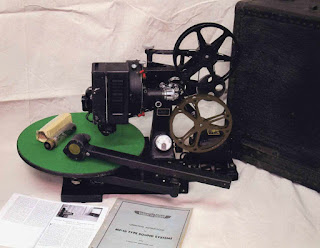Your unit test will cover the following material.
You should be familiar with the term, device, person, or concept, and be able to explain why this thing was important or significant or how it influenced or helped contribute to early film history.
All material mentioned was either referenced and discussed below in the blog (check and review blog entries), the handouts from Turning Points in Film, additional printed sources (handouts), films we watched in class, or from Tim Dirks website (Film History). Please refer to your notes and study. This test covers a lot, please study. Please. No. Really. Study. Review your notes. And study those notes--that's why you took them!
You should be familiar with the term, device, person, or concept, and be able to explain why this thing was important or significant or how it influenced or helped contribute to early film history.
All material mentioned was either referenced and discussed below in the blog (check and review blog entries), the handouts from Turning Points in Film, additional printed sources (handouts), films we watched in class, or from Tim Dirks website (Film History). Please refer to your notes and study. This test covers a lot, please study. Please. No. Really. Study. Review your notes. And study those notes--that's why you took them!
- Styles of film: realism, classicism, formalism
- Early film invention: Magic Lantern, Daguerreotype, Celluloid, Kinetoscope, Mutoscope, Praxinoscope, Thaumatrope, etc. You should be familiar with these devices and how they utilize persistence of vision, or how they influenced early film making.
- Edweard Muybridge, photography, & the Zoopraxinoscope
- The Lumiere Brothers & their films (The Sprinkler Sprinkled, Arrival of a Train, etc.)
- Pathe Frere Manufacturing Company (Charles Pathe)
- Pathe Films: Onesime the Clock Maker; Slippery Jim; Aladin; The Policeman's Little Run
- Thomas Edison and the Edison Manufacturing Company: various films (Sandow the Strongman, Serpentine Dances, Frankenstein, The Wizard of Oz (1910), Life of an American Fireman, etc.
- The Black Maria
- Augustin Le Prince & the "Roundhay Garden Scene"
- W.K.L. Dickson & his works
- Hepworth Manufacturing Company (Cecil B. Hepworth)
- Hepworth's films: Rescued by Rover ; How It Feels to be Run Over; Explosion of a Motor Car; That Fatal Sneeze; Alice in Wonderland
- George Melies & A Trip to the Moon
- Persistence of Vision
- Etinnene-Jules Marey & the photographic gun
- George Eastman & his contribution to the film industry
- Ferdinand Zecca
- Edwin S. Porter & his films: The Great Train Robbery ; Dream of a Rarebit Fiend; Life of an American Fireman
- Actualities
- D.W. Griffith and his contribution to film (also his Intolerance, Way Down East, and Birth of a Nation, etc.)
- Billy Bitzer & contributions to cinematography/photography
- Lillian Gish
- Thomas Harper Ince
- Early film comedy and comedians (particularly Mack Sennett, Mabel Normand, Harold Lloyd, Harry Langdon, Billy Bevan, Fatty Arbuckle, Buster Keaton, Charlie Chaplin, etc.)
- Slapstick comedy & comedic techniques
- Charlie Chaplin (various films; we watched clips; The Rink & The Circus in class, but others were mentioned)
- Buster Keaton (we watched One Week, clips from Steamboat Bill, Jr., & Sherlock Jr. in class; but view other examples of the great "stone-face")
- Roscoe “Fatty” Arbuckle & his scandal (Hays Code chapter)
- Hollywood (the origin and development of)
- United Artists
- Eisenstein & Montage & Battleship Potemkin (Odessa Step sequence)
- The 5 types of montage & how they work
- Dziga Vertov: "Man With a Movie Camera"
- Nanook of the North & Robert Flaherty
- Types of Shots (close up, medium shot, full shot, deep focus shot, long shot, extreme close up and long shots, panning, dolly/tracking shot, etc.) and how and why they are used
- Types of Angles (high, low, bird's eye, oblique, etc.) and how and why they are used
- Advice about Camera shots and editing
- Lighting: high key, low key, and chiaroscuro
- Sound: Diegetic & non-diegetic
- Early independent film studios/the Hollywood Studio System
- Early major film studios (1920-1930)
- Goldwyn, Fox, & Warner Bros. (studios)
- Blockbooking
- Sid Grauman & the Chinese Theater
- MPPC, MPPDA & AMPAS
- The Academy Awards
- The Hays Code
- German Expressionism & its influence (expressionism)
- F. W. Murnau & Nosferatu; Sunrise
- Robert Weine & The Cabinet of Dr. Caligari
- Fritz Lang & Metropolis
- Carl Laemmle
- Birt Acres
- R.W. Paul
- Alice Guy-Blache
- Mack Sennett
- Douglas Fairbanks
- Rudolph Valentino
- Mary Pickford
- Lilian & Dorothy Gish, & Mae Marsh
- Clara Bow
- Cecil B. DeMille
- Oscar Micheaux
- Minorities in film
- Conrad Veidt
- Lon Chaney, Man of a Thousand Faces
- Lois Weber
- Nickelodeons & early Movie Palaces
- Kinemacolor & early "special effects" such as tinting or painting celluloid
- Steven Spielberg; Raiders of the Lost Ark (1981)
- George Lucas & Star Wars (1977)
- Characteristics of Blockbusters
- CGI (computer generated imaging) & its contribution to contemporary film (see CGI chapter)
- Elements of narrative film (narratology)
- Film vocabulary:
- Auteur, Story, Plot, Order, Narration, Narrative Form, Narratology
- Diegesis, Scene, Frequency, Motif
- Space, Viewing Time, Duration
HOMEWORK: Please study for your exam, please study for your exam, please study for your exam.




